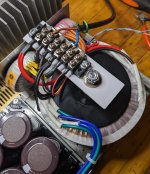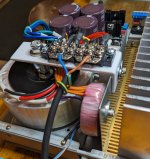Yes it's All Clad. Had to replace some other pots we had that didn't work with induction.
Faster and more even heat than gas and responds instantly when you turn it down. Doesn't scorch like gas either.
Faster and more even heat than gas and responds instantly when you turn it down. Doesn't scorch like gas either.
Wow. The build is actually beautiful to me. Neat wiring and attention to detail. It is the kind of thing could happen to anyone. I second the thought of using Nylon or other sturdy product. The responses were all spot on, and that really helps when you are trying to troubleshoot a basic flaw. I want to see more photos of this project. From what I already have seen, I would likely get some good ideas for a future build.
A common mistake! At least you now know👍It's always good to learn something new. Maybe this is common knowledge, but I learned that surrounding a toroid with a ground is a bad idea.
I thought the small adjacent toroids were creating some competing magnetic fields and causing the problem, but that was not the case. When I disconnected them from the terminal block the problem persisted. But as soon as I removed the terminal block and bracket going across the top, the problem went away.
Go figure.
If you want to keep the cooker top pristine, put a sheet of grease proof paper between the cooker surface and your pan.Yes it's All Clad. Had to replace some other pots we had that didn't work with induction.
Faster and more even heat than gas and responds instantly when you turn it down. Doesn't scorch like gas either.
Thank you. I actually like the fabrication as much as the electronics. The chassis is an old 70's Kenwood receiver that I'm retrofitting with a modern PS, amp, and preamp. Space is tight so I have to be careful with the layout. This is my 3rd build like this, I love that era.The build is actually beautiful to me
I'll post more pics as it slowly progresses.
Great tip. There are times when I want to shake the food in the pan but I don't want to scratch the surface.put a sheet of grease proof paper between the cooker surface and your pan.
So do you mean like parchment paper?
It's always good to learn something new. Maybe this is common knowledge, but I learned that surrounding a toroid with a ground is a bad idea.
I thought the small adjacent toroids were creating some competing magnetic fields and causing the problem, but that was not the case. When I disconnected them from the terminal block the problem persisted. But as soon as I removed the terminal block and bracket going across the top, the problem went away.
Go figure.
Did you try to float the bracket so it wasn't connected to ground?
As is, it looks like it creates a current path to ground via inductive coupling, huh?
YesGreat tip. There are times when I want to shake the food in the pan but I don't want to scratch the surface.
So do you mean like parchment paper?
I'm going to make a new bracket out of nylon or some type of sturdy plastic. Something like this product would work good.Did you try to float the bracket so it wasn't connected to ground?
https://www.homedepot.com/p/MSI-Whi...Tile-Trim-3-ln-ft-Each-THD2WH2X36DB/202521103
Do you ever find yourself in such store where you avoid the salespeople so that you don't have to explain to them what you want and why?
"Can I help you?"
"Yes, I'm looking for a non-ferrous material that I can use to construct a bracket for supporting a terminal block that will be suspended over a high current toroid transformer."
"Yes, I'm looking for a non-ferrous material that I can use to construct a bracket for supporting a terminal block that will be suspended over a high current toroid transformer."
Yes, I am laughing too. If they came up with a direct answer or understanding of the concept that would be pretty scary too. "Yes sir, in aisle #14 we have strips of material that could be cut to size and have an electrical insulation property out to 14KV. Let me know if you need me to help you calculate."
The reason it seemed to be in the bolt and bracket, is because it was. If you were to short your secondary windings, you'd expect to have all the current flowing through them too. The bracket with bolt going through it was creating exactly that, albeit the winding was made out of steel and it was just one turn.It's interesting in that the excess current seemed to be in the bolt and bracket, that's where I noticed the most heat. The transformer didn't seem to get warm, so hopefully I didn't damage it.
The bolt and bracket were simply the smallest amount of surface area per cross section of material, so it would get hotter as the heat can't be dissipated as easily.
The primary was probably heating up too - but it would have taken a while for the heat to reach the surface. And if the shorted turn were very lossy compared to copper wire, the resistance at say a half volt induced in it might have limited primary current to something reasonable anyway. Half a volt (per turn, typical of a toroid around 200-400 VA) at 200 amps is only 100 VA. It’s when you get thousands of amps in a shorted turn that things get interesting. Might not even hurt the transformer, but cause things to melt.
Maybe not. I measured .5 amps so it would take most of that to heat the bolt and bracket. A 60w soldering iron.The primary was probably heating up too
Like an induction stove. Copper pots and pans don't heat well because they aren't lossy enough.And if the shorted turn were very lossy compared to copper wire,
It is hard for me to forget when I mis wired a dual primary on a transformer. It was not that large. Maybe in the10 VA range or so. It was toroid, and it got hot in a few seconds. Maybe 3.
I cut up a plastic case that I found and it worked perfect. The cover I got for the terminal block is the wrong size.
No more toaster.
Thanks for all the wisdom.
On to the next stage...P3A
No more toaster.
Thanks for all the wisdom.
On to the next stage...P3A
Attachments
Last edited:
Yep, I've smoked a few things over the years too.
And not just components 😎
The first power supply I ever built didn't have an ON/OFF switch.
Young.
Fearless.
Wired the big caps backwards.
Didn't so much smoke as they blew up.
- Home
- Amplifiers
- Power Supplies
- Transformer primaries out of phase?

